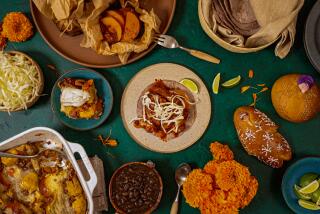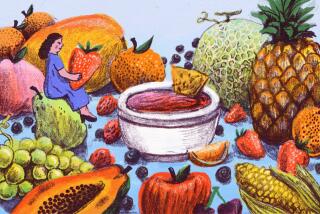A summer twist on pisco sour, caipirinha cocktails

- Share via
YOU’VE stuffed dozens of Chilean empanadas de pino (savory wheat pastries with spiced beef and onions), scoured online for a clay pot to cook an authentic Brazilian moqueca (seafood and coconut milk stew), and downloaded enough bossa nova tracks to last until the wee hours. All you need to get your guest’s inner samba dancers moving is some off-the-beaten-path summer cocktails packed with fresh fruit and herbs. Aguardiente (fire water) to the rescue. Variations on classic South American cocktails such as pisco sours (a frothy citrus cocktail) and caipirinhas (a potent Brazilian specialty) are appearing on cocktail menus all over town, and they’re a cinch to make at home for a crowd.
Pisco, the base for the pisco sour, is a grape brandy similar to grappa. It’s found in the winemaking regions of Chile (where it’s aged in oak barrels), as well as in Peru (where it’s aged in clay pots).
The origin of the pisco sour is hotly debated (both countries claim it as their national cocktail). Most likely the drink -- Chilean or Peruvian pisco, egg whites and dash of bitters -- was first shaken up in the 1920s as a whiskey sour alternative.
The backbone of a caipirinha is cachaça, a Brazilian rum made from freshly pressed sugar cane juice that’s typically light and fruity. Caipirinhas have an equally elusive history in Brazil. Cachaça production is traceable to 16th century Portuguese sugar cane plantations, but discussions about the origins of the cocktail are speculative. As Brazilian restaurants in the U.S. have become popular in recent years, the caipirinha, a refreshingly simple combination of muddled limes, sugar and cachaça has been appearing on cocktail menus.
Cocktails at play
EITHER cachaça and pisco is a winning match for summer citrus and fresh herbs, and both are inexpensive, usually less than $25 -- affordable enough to keep those caipirinhas and pisco sours going all night.
co-owner and chef Mary Sue Milliken says she was turned on to both cocktails 10 years ago after a vacation in Chile. “They’re such festive drinks, and so easy too. For a caipirinha, you smash the fruit in a glass, add a little cachaça and sugar, and pisco is so clean and lovely you just need lemon juice and sugar.”
From there, it’s easy to play around with the classic recipes. In the tongue-twisting Caipitetra, Milliken substitutes muddled oranges and mint for the caipirinha’s limes and uses fragrant honey instead of sugar to give the cocktail a floral edge. But she doesn’t completely forgo lime juice -- a generous squeeze is included for acidity and balance. For a pretty do-ahead patio brunch refresher, you can juice the oranges ahead of time and muddle the orange wedges and mint -- mash them several times with a muddler or the back of a spoon -- before those empanadas are even out of the oven.
“Cachaça has a sweeter, lighter flavor than rum, with a fruity, fresh quality, so it works really well with things like strawberries and mango, not just citrus,” says Philip Spee, bar manager at at the Beverly Hills Hotel.
It’s that fragrant aroma and flavor that makes cachaça a natural partner with berries and tropical fruits.
At Ortega 120, a new Latin-fusion restaurant in Redondo Beach opening this weekend, co-owner Demetra Stevens packs enough fresh raspberries, strawberries and chunks of pineapple and peaches to fill a pint glass when she makes the caipirinha do fruta. She vigorously shakes the raspberries with cachaça until they dissolve to lend a pretty pink hue; the remaining fruit floats in the cocktail as a drinkable spiked fruit salad.
At Table 8 in Los Angeles, the pomegranate caipirinha -- a mix of pomegranate juice, lime and cachaça -- is decidedly more straightforward but no less festive.
Lime lovers experiment by playing around with herbal additions to the classic caipirinha. Sweet basil with its anise note lends a just-picked, sweet-and-savory flavor to Spee’s Thaipirinha. You could also muddle fresh Thai or lemon basil for your own variation. Or try a version with mint, a close cousin to basil that lends a refreshing, cooling quality to what is essentially a summer mojito with lighter, fragrant cachaça substituted for the rum.
Fruitful experiments
TO MAKE a similar version at home, muddle your fresh herb of choice (Spee plans to experiment with cilantro next) with quartered limes and simple syrup. Fill a shaker with ice and add the cachaça, shake well and strain into an ice-filled glass. For a lighter cocktail, top off the drink with a splash of soda.
According to Ray Srp, master mixologist for the Bellagio in Las Vegas, “Pisco is a little more mellow than cachaça with a dry, fruity flavor from the grapes. It’s more akin to vodka, although more aromatic but with the same versatility, so you can use it with a variety of fruits.”
At the Bellagio, Srp serves a tasting flight of three pisco sours: lime, pomegranate and passion fruit. When experimenting with tropical fruits, he recommends adding the tartness of lemon or lime to temper the tendency for tropical cocktails to become too soft. (Which citrus depends on your palate. Peruvians typically use lime juice, but in Chile, lemon juice is more common. And of course, some varieties of lime are lemony.)
Srp’s Sideways Sour is a play on pisco’s origin in grapes, adding white grape juice and Pinot Noir (he recommends a jammy California Pinot to lend body). A shot of orange-scented Cointreau liqueur complements the fruity nose of the pisco -- a generous pour of assertive sweet and sour (lemon juice and simple syrup) prevents the cocktail from being cloying.
To make the dramatic cocktail for a party, combine the pisco, orange liqueur, grape juice and sweet and sour in a pitcher and pour over ice into cocktail glasses. Before handing a drink to each guest, slowly pour the wine over the back of a spoon so it floats on top (go ahead and use a good-quality Pinot; it can serve double duty as the dinner wine). Hand over the crimson-kissed cocktail, turn up the samba music, and settle in to enjoy sophisticated South American flair.
More to Read
Sign up for The Wild
We’ll help you find the best places to hike, bike and run, as well as the perfect silent spots for meditation and yoga.
You may occasionally receive promotional content from the Los Angeles Times.










